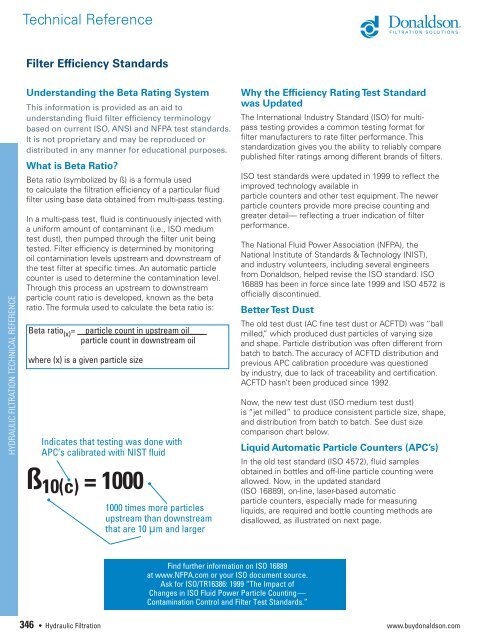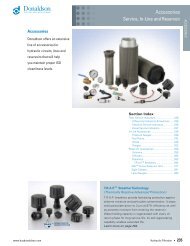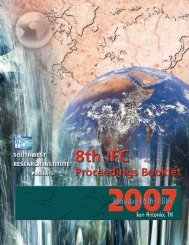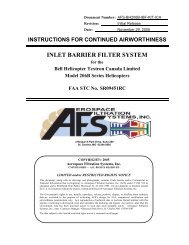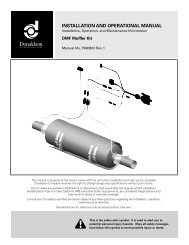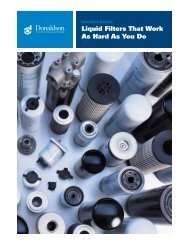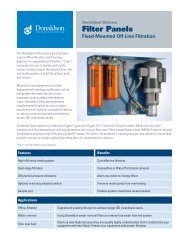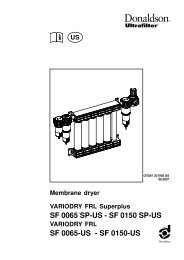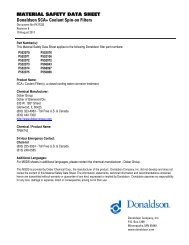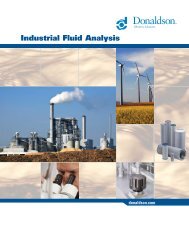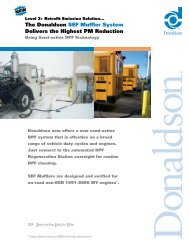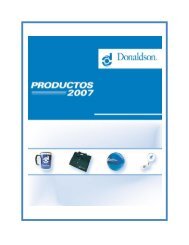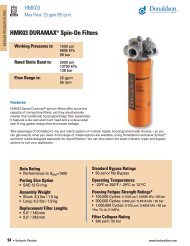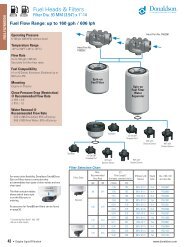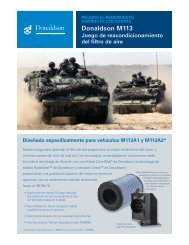Hydraulic Filtration Technical Reference - Donaldson Company, Inc.
Hydraulic Filtration Technical Reference - Donaldson Company, Inc.
Hydraulic Filtration Technical Reference - Donaldson Company, Inc.
Create successful ePaper yourself
Turn your PDF publications into a flip-book with our unique Google optimized e-Paper software.
HYDRAULIC FILTRATION TECHNICAL REFERENCE<br />
<strong>Technical</strong> <strong>Reference</strong><br />
Filter Efficiency Standards<br />
Understanding the Beta Rating System<br />
This information is provided as an aid to<br />
understanding fluid filter efficiency terminology<br />
based on current ISO, ANSI and NFPA test standards.<br />
It is not proprietary and may be reproduced or<br />
distributed in any manner for educational purposes.<br />
What is Beta Ratio?<br />
Beta ratio (symbolized by ß) is a formula used<br />
to calculate the filtration efficiency of a particular fluid<br />
filter using base data obtained from multi-pass testing.<br />
In a multi-pass test, fluid is continuously injected with<br />
a uniform amount of contaminant (i.e., ISO medium<br />
test dust), then pumped through the filter unit being<br />
tested. Filter efficiency is determined by monitoring<br />
oil contamination levels upstream and downstream of<br />
the test filter at specific times. An automatic particle<br />
counter is used to determine the contamination level.<br />
Through this process an upstream to downstream<br />
particle count ratio is developed, known as the beta<br />
ratio. The formula used to calculate the beta ratio is:<br />
Beta ratio (x) = particle count in upstream oil___<br />
particle count in downstream oil<br />
where (x) is a given particle size<br />
Indicates that testing was done with<br />
APC’s calibrated with NIST fluid<br />
ß10(c) = 1000<br />
346 • <strong>Hydraulic</strong> <strong>Filtration</strong><br />
1000 times more particles<br />
upstream than downstream<br />
that are 10 µm and larger<br />
Find further information on ISO 16889<br />
at www.NFPA.com or your ISO document source.<br />
Ask for ISO/TR16386: 1999 “The Impact of<br />
Changes in ISO Fluid Power Particle Counting—<br />
Contamination Control and Filter Test Standards.”<br />
Why the Efficiency Rating Test Standard<br />
was Updated<br />
The International Industry Standard (ISO) for multipass<br />
testing provides a common testing format for<br />
filter manufacturers to rate filter performance. This<br />
standardization gives you the ability to reliably compare<br />
published filter ratings among different brands of filters.<br />
ISO test standards were updated in 1999 to reflect the<br />
improved technology available in<br />
particle counters and other test equipment. The newer<br />
particle counters provide more precise counting and<br />
greater detail— reflecting a truer indication of filter<br />
performance.<br />
The National Fluid Power Association (NFPA), the<br />
National Institute of Standards & Technology (NIST),<br />
and industry volunteers, including several engineers<br />
from <strong>Donaldson</strong>, helped revise the ISO standard. ISO<br />
16889 has been in force since late 1999 and ISO 4572 is<br />
officially discontinued.<br />
Better Test Dust<br />
The old test dust (AC fine test dust or ACFTD) was “ball<br />
milled,” which produced dust particles of varying size<br />
and shape. Particle distribution was often different from<br />
batch to batch. The accuracy of ACFTD distribution and<br />
previous APC calibration procedure was questioned<br />
by industry, due to lack of traceability and certification.<br />
ACFTD hasn’t been produced since 1992.<br />
Now, the new test dust (ISO medium test dust)<br />
is “jet milled” to produce consistent particle size, shape,<br />
and distribution from batch to batch. See dust size<br />
comparison chart below.<br />
Liquid Automatic Particle Counters (APC’s)<br />
In the old test standard (ISO 4572), fluid samples<br />
obtained in bottles and off-line particle counting were<br />
allowed. Now, in the updated standard<br />
(ISO 16889), on-line, laser-based automatic<br />
particle counters, especially made for measuring<br />
liquids, are required and bottle counting methods are<br />
disallowed, as illustrated on next page.<br />
www.buydonaldson.com


